Here are five points that deserve emphasis when considering the ground fabric for hand embroidery:
1. Importance of the ground: The “ground fabric” (the fabric on which you work your embroidery) is as important as the design, threads, colors, and techniques that you employ – and sometimes, it’s more important!
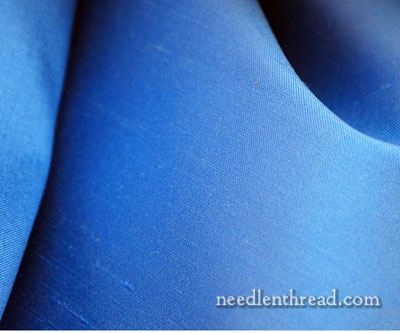
2. Quality: Any fabric can be embellished with hand embroidery, but some fabrics are better than others. Better fabric always yields better final results, and usually, you get what you pay for. Don’t put money and time into an embroidery project that is worked on cheap, low-quality fabric that isn’t suited to hand embroidery. If nothing else, the fabric won’t last as long, and your embroidery efforts will not look as good as they could.
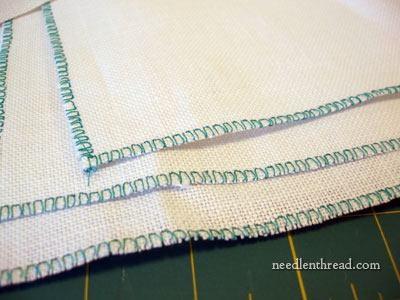
3. Grain: Fabric has grain. There’s the lengthwise grain, which runs parallel to the selvedge (the edges as the fabric comes off the bolt). There’s the “cross grain” which runs perpendicular to the selvedge. And there’s the bias, which runs catercorner to the length & cross grain. Squaring up the ground fabric so that it can be mounted to a frame (or in a hoop) on the grain lends to better results. Mounting your fabric off grain often leads to puckering or warping.
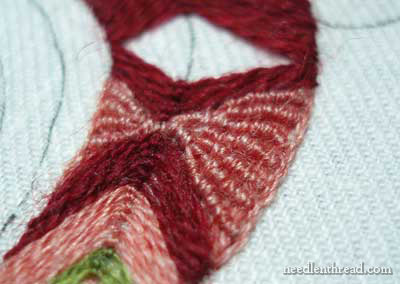
4. Support: Weight & weave, stitch type & density need to be considered when choosing a fabric. The ground fabric needs to support the type of stitching you plan to do. Denser, heavier stitching generally requires stronger fabric with a weave that will hold the stitching. The opposite is also true: light, delicate stitching will be lost on burlap.
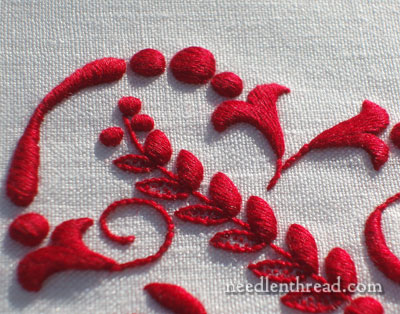
5. Care, Preparation, & Use: Consider how the project will be used before you select your fabric. If the project is meant to be laundered, or will be used on an item that may need laundering, or will be displayed in a place that will require its being cleaned now and then, choose a ground fabric (and an embroidery technique) that will withstand laundering. When working with linens and cottons, pre-shrink your fabric and rinse the sizing out. Some experts say this isn’t necessary, but in fact, it never hurts to rinse out and pre-shrink linens and cottons before you start stitching. Better safe than sorry.





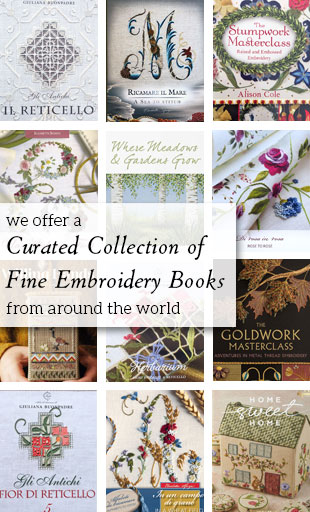

Thank you Mary for these excellent reminders! I learned one other thing while at the Royal School many years ago. If in doubt about the sturdiness of a linen for crewel, back it with muslin. This has opened up my fabric choices immensely. I even back the Strathaven linen simply to get a background that won’t move. Many of the linens are thick enough but they have a tendency to get stretchy. Muslin cures that problem. I wash both the linen and the muslin before starting.
I’m just starting out with embroidery, but one of the projects I want to start soon is a couple fairies on denim. I just wanted to know your thoughts on using denim as a ground fabric before I start it and have it look bad. Thanks.
I just discovered your blog and I’m so happy I did! I love your free patterns and sensible tips! 🙂
Finding fabric stores that carry high quality materials has turned into a tougher chore than I anticipated. An inability to take leave from work to travel distances from my rural area exacerbates the difficulty. Are there online sources of fabrics you would recommend?
Hi, All – Thank you for your comments!
Jon – denim is really a fairly heavy (more or less) twill fabric, normally cotton but sometimes with synthetic elements. You can certainly embroider on it. I’d suggest getting handy with a thimble of some kind – it can be somewhat hard on the fingers, because it’s a fairly tough fabric!
Dhivya – Yes, that’s correct. When you “back” another fabric (or “line” it), you’d be stitching through both layers of fabric. A backing fabric is used when the “ground” fabric (the fabric your embroidery is showing on) needs extra support to hold your stitching or to stabilize it.
Enid – I think it depends on the type of fabric you are looking for. I buy embroidery linen from Hedgehog Handworks. Any other type of fabric (quality silks, velvet, velveteens, etc.), I usually find at finer fabric type stores (not chain fabric stores, like JoAnn’s, or “discount” big volume online fabric shops). The type of shop you’d be looking for is normally locally owned, has been in the area for a long while, and is usually found in downtown areas in big cities, or in outlying nicer shopping areas. Sometimes, you really have to look to find them, but most large cities do have them.
Barbara – Thanks for adding the tip on backing linen with muslin. That’s what I love about your “smalls” crewel kits – they include the muslin backing with the Strathaven. They’re terrific little kits!
~MC
These are things I did automatically because that was what I was taught. But Thank you Mary, for the excellent points made.
Hi, Jon! My fabric of choice is denim–the same kind of denim twill you’ll see in jeans. I admit, I don’t do a LOT of stitching, but I love the hand of the fabric and the density of even lightweight stuff, as it will support pretty much anything without overpowering it with texture or appearance.
Remember the fad for embroidered back pockets? Same idea. 🙂
Give it a try as a sample, and see how you like it–we’re all different in our preferences, I think. 🙂
Hi Mary,
I do embroider, but not as much. So I am very puzzled what is this ground fabric and the backing fabric. The name as it means I understand using 2 fabrics together to embroider. Could you please give a short explanation/difference. And when is it used….
Many Thanks
Dhivya G
Thanks for this great advice!
I was just wondering what sizing was. Is it something manufacturers put on fabric, or something used to pre-shrink fabric? Or something completely different?
[Side Note – it’s odd when a word/concept is the same in seemingly different contexts. Sizing is also used to shrink fabric onto frames to make flats (the “walls” on sets) in theater. Just thought I’d share an odd bit of knowledge I learned in high school theater way back when.]
Also, I’ve bought a few of Trish Burr’s thread painting books, she recommends putting iron-on interfacing on the back of fabric before embroidering. What were your thoughts on this?
Thanks for the amazing blog – it’s one of my first resources for embroidery info. I’m sure you put a lot of work/thought into this site and I really appreciate the result!
Hi, Sarah – Sizing in textiles is a protective coating on the threads to make weaving them easier. I think normally the warp threads are sized. But not all sizing is the same, and not all fabrics & manufactures use the same “recipe” for their sizing. I don’t use iron-on interfacing ever with embroidery, but that doesn’t mean it can’t be done. It’s just my preference not to. I wonder if that’s in one of Trish’s earlier books… she may have changed her approach since then. I’ll have to ask her! ~MC
Regarding preshrinking–normally that’s good advice but certain embroideries, such as Hardanger, are meant to be stitched before washing the fabric. Once the embroidery and cutwork are done, then you wash the project in hot water to shrink the fabric a bit, tighten the stitches, help the cut ends move under the stitches so they’re not as visible, and make the embroidery “pop.” I believe this is also true for some other cutwork embroidery on linen.
I have recently begun embroidery again after many years. The only supplies I can find are at Joann Fabric & Hobby lobby. The qualith of thge stamped fabrid they carry is very poor. I have purchased a few transfers and put them on hand towell for christmas givts but the fabric is poor. Where do you buy good stamped items or good towels & Pillow cases to do your self.
Cathie – I’d head for any store that carries good quality kitchen/bath/bed items, and avoid the craft stores. For really special fabrics, you might have to hem your own towels and pillowcases. It’s all straight line sewing so it’s not difficult. I’ve only found plasticy-feeling poly-cotton blend pillowcases or thin cotton towels at the chain craft stores. I have some poly-cotton pillowcases my mom embroidered, and the fabric actually cut through the floss. I’m a bit sad as they were done by Mom, and it was a cute design with a fawn.
@ Enid- You’ll be happy to know, Threads magazine has good taste when it comes to fabrics. They posted an article a while ago, “Where Do The Threads Editors Buy Their Fabric?” They list seven store with internet purchasing. Her is the link to the article…
http://www.threadsmagazine.com/item/7447/where-do-the-threads-editors-buy-their-fabric
I’ve been using one of the stores, Mood Fabric, and yes, they have a large selection of fabrics, some of which are modestly priced. I trust this has been of assistance to you. I hope this reaches you!
@ Enid- You’ll be happy to know, “Threads” magazine has good taste when it comes to fabrics. They posted an article a while ago, “Where Do The Threads Editors Buy Their Fabric?” They list seven stores with internet purchasing. Here is the link to the article…
http://www.threadsmagazine.com/item/7447/where-do-the-threads-editors-buy-their-fabric
I’ve been using one of the stores, Mood Fabrics, and yes, they have a large selection of fine fabrics, some of which are modestly priced. I trust this has been of assistance to you. I hope this reaches you!
Where can I find directions as to how to do double stem stitch?
Carol – Double stem stitch, from what I can tell, is two rows of stem stitch worked close together. I’ve not come across stitch directions for a specific stitch that is worked in any way different from stem stitch, that’s called “double stem stitch,” so I can only assume what’s meant is two rows of stem stitch, worked close together.
@ Carol, I think “double stem stitch” is as Mary has said, two rows of stem stitch worked side-by-side or within a mere fraction of an inch of each other. The reason why I say this is because in the Woman’s Day Book of American Needlework by Rose Wilder Lane, (1886-1968), daughter of Laura Ingalls Wilder (1867-1957), there is shown a “double seed stitch” and this is worked as described above. I like to research the stitches and needlework as far back as possible, that way I get a less diluted source of reference.
I have started refering your website when I have any doubts.
I would like to know if you can teach a design to a group that another teacher has taught and does not make into charts and sell on the open market. This is their source of income.. Is that the same as you explained according to your copyright opinion? We have a group that thinks it is okay and I am not sure. I respect your opinion. I wpuld appreciate your opinion. as they have used your judgement to do so. Thank You Judy
Normally, no, you can’t. If it’s someone esle’s design and project, whether they sell it on the open market or not (sometimes, teachers reserve certain projects just for classes, which are also a source of income for them) and you don’t have permission to use it, you can’t. However, if it is a kit, and everyone buys the kit, or if it is a project in a book, and everyone either buys the book or the author has given permission for the project from the book to be used in a class, then yes.
I don’t think I ever said that a group could take another teacher’s project or design and use it in another class. If I was interpreted that way, I’d love to know on what basis the interpretation was made!
It’s always best to ask for permission to use a project or design that obviously originates from another person in any kind of class or group project.
hello – I am new to hand embroidery and would like to know what you think about using a batik for the ground fabric.
thank you
Hello Mary! I’m so glad to have stumbled upon your site. In making stockings for my family this year for Christmas, I choose a satin cuff which I began satin stitching names on using three strands of a DMC cross-stitch thread and a hoop. As I’m new to embroidery (other than cross-stitching) I began a test sample and I’m not happy with how the fabric is slightly bubbling. Is satin the “wrong” fabric to use for this project? Can I solve my issue with a backing fabric or stabilizer? I do not plan on washing the final project but can if a water soluble stabilizer is the way to go. Thanks for your input!
Hi, Kimberly – it really really depends on the type of satin. A heavier silk satin with some body to it would make a better ground that would resist puckering and wouldn’t really need a stabilizer; a thinner polyester satin is more difficult to work on and lacks the crisp body that can be a joy to work on when embroidering. Another thing to consider is the size and type of your hoop. On a larger hoop – especially plastic craft hoops – it can be difficult to keep good tension on the fabric. And finally, the usual reason for puckering with embroidery is the tension of your stitches. If they are too tight, the fabric will pucker. With drum-tight fabric in a hoop, your stitches should just “sit” on the fabric without pulling the fabric. If you’re using a silk satin, a hoop can be problematic because it leaves wrinkle / hoop marks. You can reduce these by binding both rings on the hoop (there’s a tutorial for that here on NnT), or at least bind the inner ring, and then mount your satin in the hoop, along with some cotton muslin on top of the satin, and then cut out a hole in the muslin to expose your stitching area. Finally, if you do want more stability to the fabric, instead of using a fusible interfacing or any kind of adhesive stabilizer, if you back the satin with a cotton muslin and stitch through both layers (and finish the cuff with both layers of fabric), this will supply more support to the satin ground fabric, without being difficult to stitch through by hand (as many fusible and synthetic stabilizers are) and without risking the unsightly bubbles or wrinkles or even discoloration over time that can result from some fusible stabilizers. Hope that helps a little bit! – MC
I had some towels embroidered at a shop and the the backing they used is still on them. Should I remove it or leave it on
I’d just leave it on. There’s usually an interfacing on the back of machine embroidery….
Hi I am making a Japanese obi. The only satin fabric I have found that is the color I need is a light weight. I need interfacing to give it the stiffness it needs. I am wondering if I need interfacing on it before I hand embroider it. Or fabric as backing?
Any advice that would be useful?
Have you tried a silk satin? The satin weave silks are usually a bit heavier in weight. In any case, I would not interface it first, if you are using a fusible. But I would back it with other fabric, if you’re doing a lot of embroidery, because you’ll need some support for the stitching. And if you back it with other fabric (say a cotton muslin or something) then maybe you won’t have to use an interfacing?
I wanted to reply back but couldn’t see how. I am the one making the obi. The fabric I have is the ploy charmeuse satin yellow from fabric.com item no.0390241.
I think I will still need the interfacing but I can add that later. I don’t the the fabric with a cotton lining will get the con of stuff bow I need. But I can test it before I finish sewing it together.do I just sew it together on the edges before putting it in the hoop?
Hi Mary, I want to embroider on silk fabric with threads DMC, sating stitch and long and short, french knots,
Hi Mary,
The red on white embroidery photo–is this crewel, and is there an article on this specific project? I’d like to read it.
Hello! please help me find a suitable fabric for my project: a traditional blouse that supports cross stiches models. As far as I understand, it should have between 14 and 18 threads/centimeter, or about 35-45/inch. do you know such fabric?
Hi, Delia – is the whole blouse constructed from the fabric to be embroidered, or just portions of it? Alba Maxima is a medium weight linen with approximately 40 threads per inch. It might be a little heavy for a blouse, but it depends on the style and so forth. You can find it through Needle in a Haystack in Alameda, CA.
I want to embroider directly onto a wool blanket how is the best way to do this? I am a complete novice and have never used embroidery in the past but would like to create a free stitching technique similar to colouring a picture with shading etc. I hope you can help me.
Kind regards.
Sue